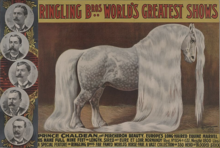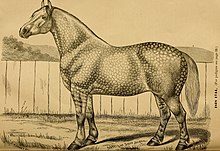
The Godolphin Arabian, also known as the Godolphin Barb, was an Arabian horse who was one of three stallions that founded the modern Thoroughbred. He was named after his best-known owner, Francis Godolphin, 2nd Earl of Godolphin.

The Percheron is a breed of draft horse that originated in the Huisne river valley in western France, part of the former Perche province, from which the breed takes its name. Usually gray or black in color, Percherons are well-muscled, and known for their intelligence and willingness to work. Although their exact origins are unknown, the ancestors of the breed were present in the valley by the 17th century. They are believed to descend from war horses. Over time, they began to be used for pulling stagecoaches; and later, for agriculture and hauling heavy goods. In the late 18th and early 19th centuries, Arabian blood was added to the breed. Exports of Percherons from France rose exponentially in the late 19th century, and the first purely Percheron stud book was created in France in 1893.

The Hanoverian or Hannoveraner is a German breed or stud-book of warmblood sport horse. As with other German warmblood breeds, eligibility for registration depends on performance rather than ancestry.

The Canadian is a horse breed from Canada. It is a strong, well-muscled horse, usually dark in colour. It is generally used for riding and driving. Descended from draft and light riding horses imported to Canada in the late 1600s from France, it was later crossed with other British and American breeds. During the 18th century the Canadian horse spread throughout the northeastern US, where it contributed to the development of several horse breeds. During the peak popularity of the breed, three subtypes could be distinguished, a draft horse type, a trotting type and a pacing type. Thousands of horses were exported in the 19th century, many of whom were subsequently killed while acting as cavalry horses in the American Civil War. These exports decreased the purebred Canadian population almost to the point of extinction, prompting the formation of a studbook and the passage of a law against further export.
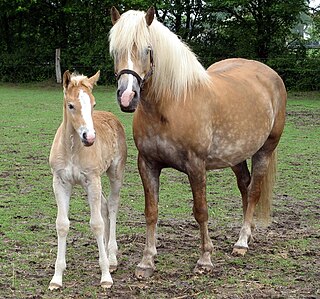
The Haflinger, also known as the Avelignese, is a breed of horse developed in Austria and northern Italy during the late 19th century. Haflinger horses are relatively small, are always chestnut with flaxen mane and tail, have distinctive gaits described as energetic but smooth, and are well-muscled yet elegant. The breed traces its ancestry to the Middle Ages; several theories for its origin exist. Haflingers, developed for use in mountainous terrain, are known for their hardiness. Their current conformation and appearance are the result of infusions of bloodlines from Arabian and various European breeds into the original native Tyrolean ponies. The foundation sire, 249 Folie, was born in 1874; by 1904, the first breeders' cooperative was formed. All Haflingers can trace their lineage back to Folie through one of seven bloodlines. World Wars I and II, as well as the Great Depression, had a detrimental effect on the breed, and lower-quality animals were used at times to save the breed from extinction. During World War II, breeders focused on horses that were shorter and more draft-like, favored by the military for use as packhorses. The emphasis after the war shifted toward animals of increased refinement and height.

The Boulonnais, also known as the "White Marble Horse", is a draft horse breed. It is known for its large but elegant appearance and is usually gray, although chestnut and black are also allowed by the French breed registry. Originally there were several sub-types, but they were crossbred until only one is seen today. The breed's origins trace to a period before the Crusades and, during the 17th century, Spanish Barb, Arabian, and Andalusian blood were added to create the modern type.

The Kladruber is the oldest Czech horse breed and one of the world's oldest horse breeds. It is considered very rare. The chief breeder and the keeper of the studbook is the National Stud at Kladruby nad Labem in the Czech Republic where Kladrubers have been bred for more than 400 years. Kladrubers have always been bred to be a galakarossier – a heavy type of carriage horse for the court of the House of Habsburg.

The Westphalian or Westfalen is a warmblood horse bred in the Westphalia region of western Germany. The Westphalian is closely affiliated with the state-owned stud farm of Warendorf, which it shares with the Rhinelander. Since World War II, the Westphalian horse has been bred to the same standard as the other German warmbloods, and they are particularly famous as Olympic-level show jumpers and dressage horses. Next to the Hanoverian, the Westphalian studbook has the largest breeding population of any warmblood in Germany.

The Tori is a horse originating in continental Estonia.

The Poitevin or Poitou is a French breed of draft horse. It is named for its area of origin, the former province of Poitou in west-central France, now a part of the region of Nouvelle-Aquitaine. It was formed in the seventeenth century when horses of Flemish or Dutch origin, brought to the area by engineers working to drain the Marais Poitevin, interbred with local horses. Although it has the size and conformation of a draft horse, the Poitevin has never been bred for draft abilities, and has been little used for draft work. Its principal traditional use was the production of mules. Poitevin mares were put to jacks of the large Baudet du Poitou breed of donkey; the resulting Poitevin mules were in demand for agricultural and other work in many parts of the world, including Russia and the United States. In the early twentieth century there were some 50,000 brood mares producing between 18,000 and 20,000 mules per year.
Studbook selection is a process used in certain breeds of horses to select breeding stock. It allows a breed registry to direct the evolution of the breed towards the ideal by eliminating unhealthy or undesirable animals from the population. The removal of individuals from a population is called culling, and does not suggest killing the animal in question. Typically, culls are castrated or they and their offspring are unable to be registered.

The Zweibrücker is a type of German warmblood horse bred in Rhineland-Palatinate and Saarland. Traditionally, the breeding of Zweibrücken was centered on the onetime Principal Stud of Zweibrücken but since 1977 has been under the jurisdiction of the Horse Breeders' Association of Rhineland-Palatinate-Saar (PRPS). The modern Zweibrücker is an elegant, large-framed, correct sport horse with powerful, elastic gaits suitable for dressage, show jumping, eventing and combined driving.
Algerine was an American Thoroughbred racehorse that won the 1876 Belmont Stakes and was the maternal grandsire of Rhoda B, the dam of the 1907 Epsom Derby winner Orby.

The Norman Cob or Cob Normand is a breed of light draught horse that originated in the region of Normandy in northern France. It is of medium size, with a range of heights and weights, due to selective breeding for a wide range of uses. Its conformation is similar to a robust Thoroughbred, and it more closely resembles a Thoroughbred cross than other French draught breeds. The breed is known for its lively, long-striding trot. Common colours include chestnut, bay and seal brown. There are three general subsets within the breed: horses used under saddle, those used in harness, and those destined for meat production. It is popular for recreational and competitive driving, representing France internationally in the latter, and is also used for several riding disciplines.

A part-Arabian, partbred Arabian or, less precisely, half-Arabian, is a horse with documented amounts of Arabian horse breeding but not a purebred. Because the Arabian is deemed to be a breed of purebred horse dating back many centuries, the modern breed registries recognized by the World Arabian Horse Organization generally have tightly closed stud books which exclude a horse from registration if it is found to contain any outside blood. However, Arabian breeding has also been used for centuries to add useful traits to countless other horse breeds. In the modern era, crossbreeding has been popular to combine the best traits of two different breeds, such as color, size, or ability to specialize in a particular equestrian discipline.

Fuschia was a trotter horse born in the Manche region of France, and head of the French Trotter breed. Winner of 17 of the 20 races in which he competed in mounted trotting from age 3 to age 5, he is best known for having been an excellent sire at the Le Pin national stud, to the point of imposing for the first time a lottery system for the allocation of breeding rights to brood mares.
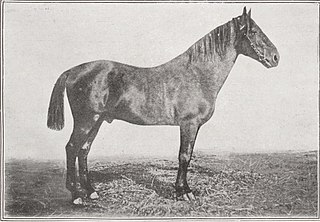
Niger was a trotter horse originated from a lineage of the now-extinct French Trotter breed. A son of The Norfolk Phœnomenon, he was a grandson or great-grandson of the English stallion The Norfolk Phenomenon. His dam, Miss Bell, was a half-blood mare of English or American origin, reputed to have served Napoleon III.

The Norfolk Phœnomenon is a black-coated stallion of the Norfolk Trotter breed. He is a son or grandson of the most famous English trotter stallion of his time, The Norfolk Phenomenon. He was imported to France in 1851 on a mission from the Haras Nationaux.

The Corlay horsebreed is a type of half-blood horse resulting from crossbreeding around the town of Corlay in Brittany, between local Breton bidet mares and imported stallions, primarily Thoroughbreds. Intended for racing, this variety of Breton horse is reputed to have impressed Napoleon III with its steeplechase abilities. As a result, local breeders specialized in this racehorse, optimizing its feed by adding maerl to the diet. Corlay horse breeding gained an excellent reputation from the mid to late 19th century. The most influential stallion in the breed was named Corlay, who bred from 1876 to 1897 in the locality of the same name. The breed was considered established by the end of the century.
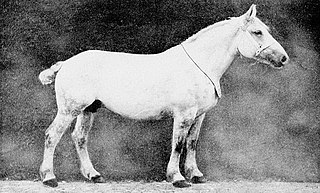
The Trait du Maine is an extinct draft horse breed originating from the region of Maine in northwestern France. Bred from the 1830s onwards by crossing mares from Mayenne with Percheron stallions, it had its own studbook due to the Percheron Horse Society refusing to include horses born outside of the Perche region. The Trait du Maine was officially recognized as a horse breed in 1926 and had up to 25,000 annual births in 1929. These horses were mainly exported to the agricultural regions of Beauce, France and Spain. In 1966, the Trait du Maine merged their studbook with the Percheron breed, which absorbed it, leading to the elimination of the Trait du Maine as a distinct breed.

